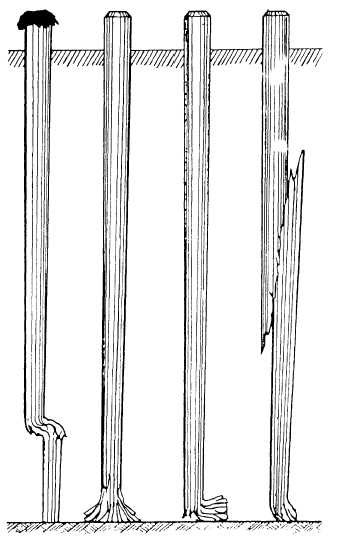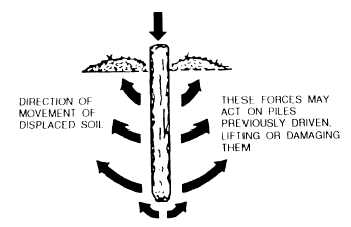surface of the ground between and around the piles then
may subside or shrink. This action may result in damage
to the foundation of nearby structures. If piles are driven
into dense sand and gravel deposits, the ground may
heave.
2. Clay soils are hard to compress in pile driving;
hence, a volume of soil equal to that of the pile will
usually be displaced (fig. 12-68). The ground will heave
between and around the piles. Driving a pile alongside
those previously driven will frequently cause those
already in place to heave upward. If the piles are driven
through a clay stratum to firm bearing beneath, the heave
may destroy the contact between the tip of the pile and
the firm stratum. Such cases maybe detected by taking
a level reading on the top of the piles previously placed.
Piles which are raised appreciably should be redriven to
a firm bearing. Soil displaced by the pile may cause
enough lateral force to move previously driven piles out
of line.
3. The sequence of driving piles in groups should
be as follows:
. Driving should progress from an area of high
resistance to one of low resistance, toward a stream, or
downslope to reduce the shoving of previous driven
piles that are out of place when succeeding piles arc
driven.
l Outer rows in the group should be driven first
if the piles derive their main support from friction. Inner
rows are driven first if the piles are supported from a
point bearing.
Figure 12-68.-Displacement of clay soil caused by driving
solid piles.
Obstruction and Refusal
The condition reached when a pile being driven by
a hammer has a 1-inch penetration per blow or zero
penetration per blow (as when the point of the pile
reaches an impenetrable bottom such as rock) or when
the effective energy of the hammer is no longer
sufficient to cause penetration (hammer is to light or
velocity at impact too little), under which circumstances
the pile may cease to penetrate before it has reached the
desired depth is known as refusal. Further driving after
refusal is likely to break or split the pile, as shown in
figure 12-69.
When a pile has been driven to a depth where deeper
penetration is prevented by friction, the pile has been
driven to refusal. A pile supported by skin friction alone
is called a friction pile. A pile supported by bedrock or
Figure 12-69.—Pile damage caused by overdriving timber
piles.
12-49



